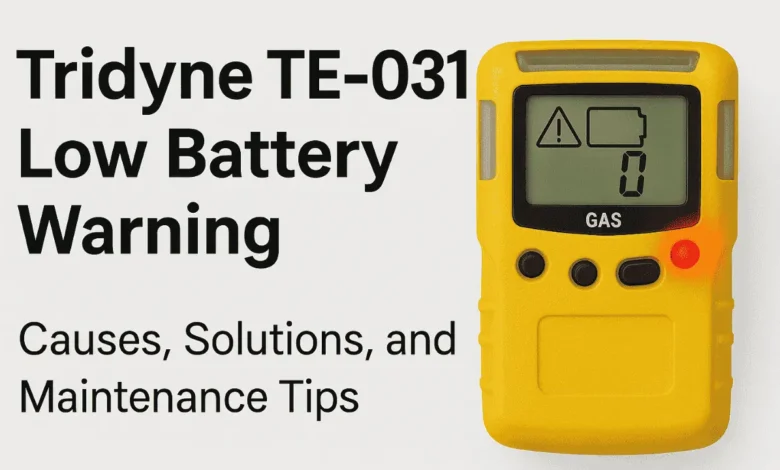Tridyne TE-031 Low Battery Warning: Causes, Solutions, and Maintenance Tips

The Tridyne TE-031 is a highly reliable gas detection device used across numerous industrial environments to monitor combustible and toxic gases. As with any electronic safety equipment, the TE-031 includes built-in features that alert users to potential issues that may compromise performance. One such critical feature is the low battery warning. This article explores in depth what the Tridyne TE-031 low battery warning means, why it happens, how to fix it, and how to prevent it through routine maintenance and best practices.
What is the Tridyne TE-031?
Before discussing the low battery warning, it’s essential to understand the Tridyne TE-031 and why it plays a crucial role in workplace safety. The TE-031 is a compact, rugged gas detector that alerts personnel to hazardous gases. It often features visual and audio alarms, digital displays, and the capability to connect with external monitoring systems.
Designed for environments like oil refineries, chemical processing plants, and manufacturing facilities, the TE-031 helps maintain regulatory compliance and protects workers by providing real-time gas level monitoring.
The Importance of Battery Power in Gas Detectors
Gas detectors like the Tridyne TE-031 rely on a continuous power supply to operate effectively. However, many of these units also have internal backup batteries to ensure continued operation during a power outage. These reserve batteries are indispensable for preserving the integrity of gas detection systems during emergencies.
A low battery is not just a minor inconvenience in such a context; it is a critical alert that needs immediate attention. When the Tridyne TE-031 displays a low battery warning, the device may soon lose its ability to monitor gas levels reliably.
Understanding the Low Battery Warning
The low battery warning on the Tridyne TE-031 is typically indicated through:
- A flashing icon on the digital display
- A dedicated battery warning light
- Audible beeps or alarms
This alert is triggered when the internal battery’s voltage falls below a safe operating threshold. The warning is an early notice, allowing users sufficient time to replace the battery before the device becomes non-functional.
Common Causes of the Low Battery Warning
The appearance of the can be influenced by a variety of factors low battery warning:
Battery Age and Wear
Rechargeable batteries degrade over time. If your TE-031 is a few years old and has not replaced its battery, this could be the root cause.
Frequent Power Interruptions
Constant power outages force the unit to rely on its backup battery more often, accelerating wear and tear.
Environmental Conditions
Extreme temperatures, humidity, or dust can affect battery performance and lifespan.
Incorrect Battery Type
Using a non-recommended battery can result in inefficient power management and trigger false low battery alerts.
Internal Hardware Issues
Sometimes, the issue lies not with the battery but internal components like the charging circuit or battery connectors.
Steps to Resolve the Low Battery Warning
Here’s a step-by-step guide on how to resolve a low battery warning on your Tridyne TE-031:
Inspect the Power Supply
Ensure that the primary power source is functional and that the unit is not operating on battery unnecessarily.
Check Battery Connections
Open the battery compartment (following the manufacturer’s safety instructions) and verify that all connections are clean and secure.
Replace the Battery
Replace the battery with a compatible model if it appears old or damaged. To avoid compatibility issues, always use batteries recommended by Tridyne.
Reset the Device
After replacing the battery, reset the unit to clear the warning. Depending on your model, this may involve holding down specific buttons or following a menu process.
Test the Unit
Once the battery is replaced and the device is reset, perform a system test to ensure it is fully operational.
Preventive Maintenance Tips
To minimize the likelihood of encountering a low battery warning, follow these preventive maintenance best practices:
Regular Battery Checks
Schedule regular checks (monthly or quarterly) to inspect battery levels, even if the warning hasn’t appeared.
Environmental Monitoring
Keep the device stable and free from excessive heat, moisture, or dust.
Scheduled Battery Replacement
Don’t wait for the battery to fail. Replace it according to the manufacturer’s suggested intervals.
Firmware Updates
Check for any firmware updates from Tridyne that might enhance battery management or overall performance.
Professional Servicing
Consider annual servicing by a certified technician to check for underlying issues and ensure peak performance.
Frequently Asked Questions
Q: How long does the backup battery in the Tridyne TE-031 last?
A: Battery life is contingent upon the amount of use and the specific model environmental conditions, but it typically lasts 1–3 years.
Q: Can I use any battery replacement for the TE-031?
A: No. To ensure safety and reliability, always use batteries that meet the specifications provided in the user manual.
Q: Is continuing the TE-031 with a low battery warning safe?
A: It is not advisable. The device may lose functionality, potentially putting personnel at risk.
Q: Does the TE-031 have a power log or alert history feature?
A: Many models do. Consult your user manual to access and interpret the device’s history logs.
Conclusion
The Tridyne TE-031 is a dependable gas detection unit, but like any device, it requires regular attention to maintain its effectiveness. A low battery warning is not something to be ignored—it is a proactive feature designed to ensure uninterrupted safety monitoring. By understanding the causes, solutions, and best practices for maintenance, you can ensure that your TE-031 continues to operate at peak performance.




